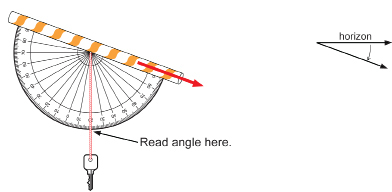Module 7
1. Module 7
1.2. Page 2
Module 7: Trigonometry
Get Started
clinometer: a device for measuring angles to distant objects that are higher or lower than your position
In the following Try This Activity you will make a “Clinometer.”
 Try This
Try This
Work with a partner, if possible.
Step 1: Print a copy of Clinometer Template.

Step 2: Glue the template to a sheet of cardboard. Then cut out the semicircular protractor.
Step 3: Tape a drinking straw to the base of the protractor as shown.

Step 4: Poke a small hole through the crosshairs at the centre of the protractor’s base. Pass one end of your thread through the hole. Knot and tape that end of the thread so it will not slip back through. Tie a weight (like a penny) to the free end of the thread.

Step 5: Let the weight swing free. When the straw is horizontal, the thread should lie along the 0° line, as shown in the diagram.
angle of elevation: an angle through which you must rotate the clinometer from the horizontal to see a higher object
When you look through the straw at an object higher than you are, your partner should be able to read the angle of elevation from the scale when the weight hangs down and is motionless.

angle of depression: an angle through which you must rotate the clinometer from the horizontal to see a lower object
When you look through the straw at an object lower than you are, your partner should be able to read the angle of depression from the scale when the weight hangs down motionless.

Practise looking through the straw and measuring angles of elevation and depression. You will use your clinometer skills throughout this module.
TT 1. What is the largest angle of elevation you can measure? In practice, angles will be significantly less.
TT 2. What is the largest angle of depression you can measure? In practice, angles will be significantly less.
Keep this clinometer somewhere safe, since you will need it in the next lesson.
Skill with Ratios
An important algebra skill you will use repeatedly throughout this module involves equal ratios. You will now review how to determine if ratios are equal.
Example 1
Are ![]() and
and ![]() equal ratios?
equal ratios?
Solution
Method 1: Reduce each fraction (ratio) to its simplest terms.


Since each ratio reduces to ![]() , the ratios are equal.
, the ratios are equal.
Method 2: Compare the cross products.
![]()
10 × 12 = 120
15 × 8 = 120
Because the cross products are equal, the ratios are equal.
The Principle
The previous example illustrates the following principle in algebra.
![]()
![]()
 Self-Check
Self-Check
In each of the following questions, use both methods from the example to compare each pair of ratios.
SC 1. Are ![]() equal ratios?
equal ratios?
SC 2. Are ![]() equal ratios?
equal ratios?